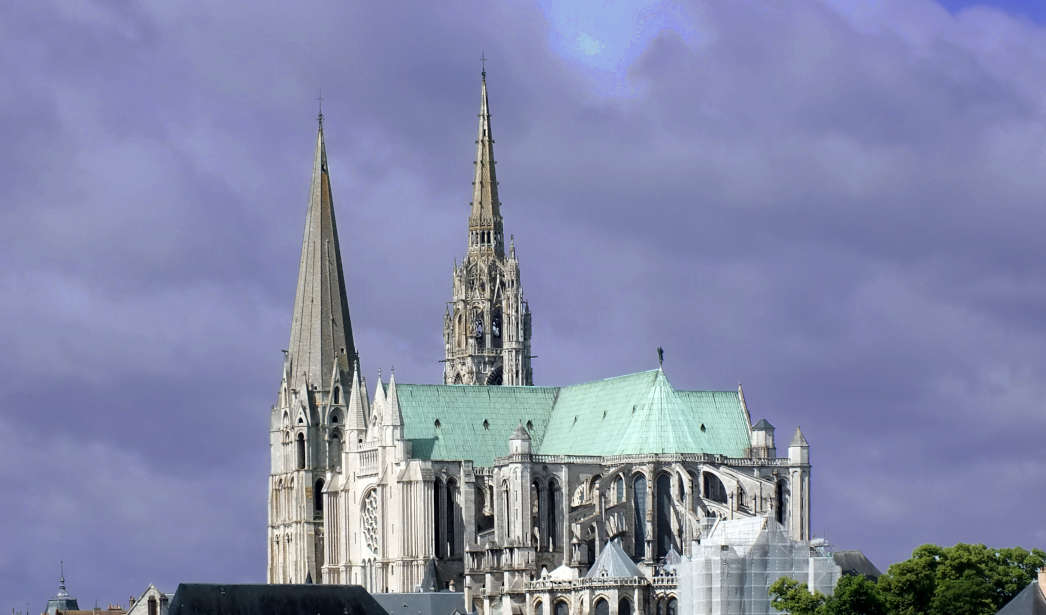
Chartres – Cathedral city
an hour from Paris
- Explore France ►
- Key pages
- Where to go
- How to get there
- More about France
About-France.com
- the connoisseur's guide to France
Chartres - jewel of provincial France
| On this page | Location and access | Sites and attractions |
| In the area | Hotels in Chartres ► |
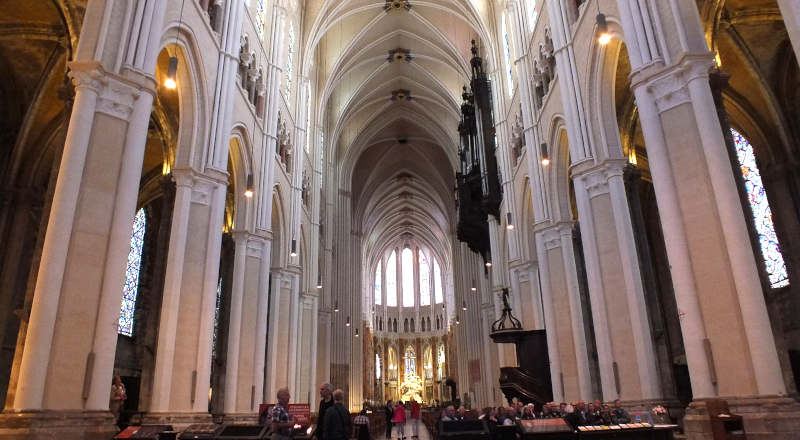
Chartres cathedral, a UNESCO world heritage site, is one of France's greatest medieval cathedrals, famous for its spires, its exquisite sculptures and its magnificent stained-glass windows, generally considered to be among the finest examples of stained glass windows in Europe.
A short History of Chartres
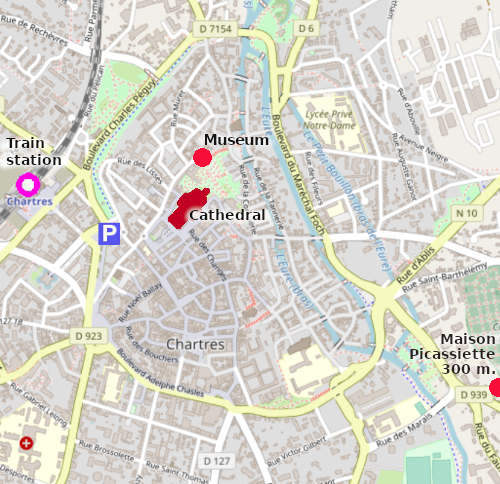 Chartres, the old town.
Chartres, the old town.In 1134 Chartres was almost totally destroyed by a devastating fire that tore through the tightly-packed timber-frame houses at an unstoppable speed. The old cathedral however was spared, and taking advantage of the occasion, the Bishop and chapter decided to extend the building westwards, giving it the dimentions of the cathedral we see today. Their work was short lived, as in 1194 the cathedral itself was burned to the ground, leaving little but its ground plan and crypt. Undaunted, Bishop Renaud de Mousson set about rebuilding the cathedral in the great new architectural style, and in the place of the romanesque edifice rose up the stunning gothic cathedral that we see today.
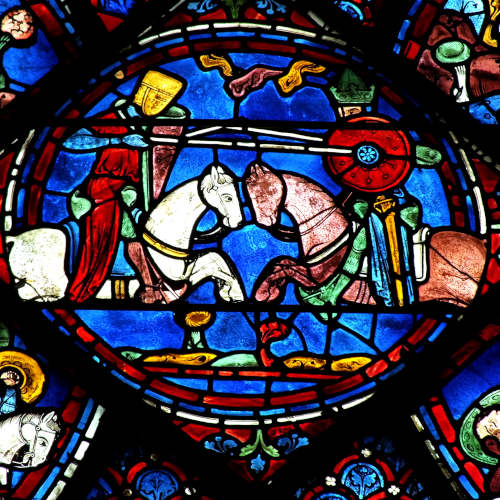
Detail froim one of the
medieval stained glass windows
Through the following centuries, Chartres, surrounded by the wheatbelt of the Beauce, became a very prosperous town and an important pilgrimage point. It was an important staging point on the medieval pilgrims' way from Paris to Santiago de Compostella, and on the routes from Paris to the Loire Valley and Paris to Tours and Bordeaux. Yet the town and the cathedral had other problems to endure. The town was held by the English for 15 years duringthe Hundred Years' War, and in 1568 was besieged by the Protestants during the Wars of Religion. To celebrate that victory, the cathedral was used for the coronation of King Henry IV, Henry of Navarre, who paradoxically had converted from Protestantism to Catholicism in order to become king.
In 1836 the roof of the cathedral was completely destroyed by fire; fortunately, as with Paris's Notre Dame cathedral in 2019, the cathedral below, though damaged, was not destroyed. Most importantly, the medieval stained glass windows survived too.
The cathedral was saved from destruction one final time during the Second World War when American colonel Welborn Griffith defied orders to destroy it; Allied intelligence suggested that the towers, with their extensive views over the surrounding countryside, were being used as a German observation post. Gutted at the idea of destroyng a priceless historic monument, Griffith took a few men and went into what was supposedly German-occupied Chartres.; they climbed to the top of the towers, and found nobody. Chartres cathedral had survived its greatest threat in modern times.
Since 2007 the interior of the cathedral has been completely renovated; instead of the dark interior known to those who visited in in earlier times, the cathedral now boasts bright walls covered in the pale plaster that was used by the original medieval builders. During the renovation, much of the stained glass was cleaned and renovated, bringing the cathedral back to a condition close to the original.
Sites and monuments in Chartres
- Notre Dame
cathedral. (Michelin Green guide *** ) After
Notre Dame de Paris, the most famous gothic cathedral in
France, dating from the 13th century. A UNESCO world
heritage site. The cathedral is home to what is commonly
considered to be the finest collection of medieval stained glass
windows in Europe.
The west facade is decorated with a magnificent collection of 12th century sculptures, illustrating the transition from the romanesque to the gothic.
- The Bishop's palace & museum - Le Palais épiscopal. Largely dating from the 18th century, the Chartres Bishops' palace, a stone's throw from the cathedral, is a historic building, largely rebuilt in the 18th century, and now home to the town's museum and art gallery. The art gallery is particularly known for its large 16th century enamals made by Léonard Limosin for King François 1e, and for its collection of works by the fauvist painter Vlaminck.
-
Maison Picassiette. This is one of France's more quirky attractions, a modest suburban house which was decorated over the years with a mosaic of hundreds of thousands of bits of glass, ceramics and metal collected and arranged by local municipal employee Raymond Isidore, one of France's great "naive" artists. Less well-known than the Maison du Facteur Cheval (in the south of France), the Maison Picassiette is altogether just as quirky and interesting.
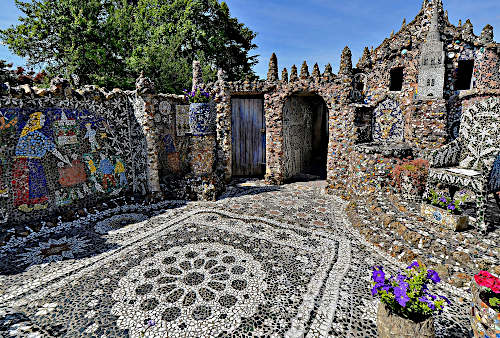
Courtyard of the Maison Picassiette - The International Stained Glass Centre - Centre international du Vitrail. Housed in a historic medieval building, this is a small exhibition centre close to the cathedral, explaining the story of stained glass. It gets mixed reviews.
- Le Compa, agricultural museum : a fitting museum for a town whose wealth has come from the agriculture of the surrounding Beauce region. Le Compa tells the story of agriculture, and particularly of the evolution of agriculture over the past two centuries. The museum contains a rich collection of historic agricultural machinery, notably tractors, and will be of interest to the whole family.
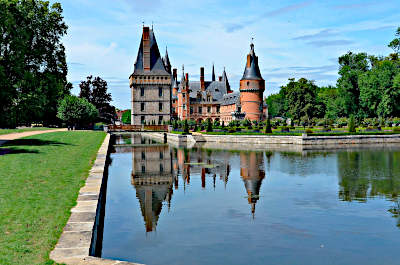
The chateau de Maintenon
1. Within 30 km of Chartres
Maintenon - 20 km northwest of Chartres, Maintenon is one of the more attractive small towns in France. Its 16th century château is like a small scale Versailles, with a lavish interior and formal gardens laid out by King Louis XIV's great landscape gardener, Le Nôtre. At the end of the gardens stand the remains of the Maintenon Aqueduct, part of a never-completed project of Louis XIV to bring water all year round to the gardens of Versailles.Meslay le Grenet - 12 km southwest of Chartres. Eglise Saint Orien. This small village church in the middle of the Beauce is decorated with a remarkbly complete and well preserved set of 15th century frescoes representing the Dance of Death.
Illiers Combray - 28 km southwest of Chartres. This is the village where life has imitated art - or literature. Originally just known as Illiers, the village was immortalised as Combray in Marcel Proust's seminal series of novels A la Recherche du Temps Perdu (in English Remembrance of Things Past - more recently retranslated as In Search of Lost Time). Villagers decided to change the name to Illiers-Combray in 1971. There is a Proust museum in what was the house of Proust's Tante Léonie, where the author spent happy childhood holidays between 1877 and 1880.
2. Less than 50 km
Chateaudun - Half an hour down the N10 road in the direction of Vendôme and Tours is Chateaudun, another small town that is worth a visit. Two attractions stand out in particular. The château of Jehan de Dunois, perched impressively on a rock beside the river Loir, is reputedly the first of the great Loire chateaux, and one of the few with a surviving medieval keep; its Renaissance wing has an exhibition of tapestries. Nearby, the Foulon Caves, les Grottes de Foulon, provide a unique opportunity to explore what was once an underground river, was later used as a shelter in neolithic times, and is now a remarkable geological site including large crystalline geodes..
About-France.com
Home page -
Site search
- Regions
- Maps of France
- Contact
Photo top of page : Chartres cathedral
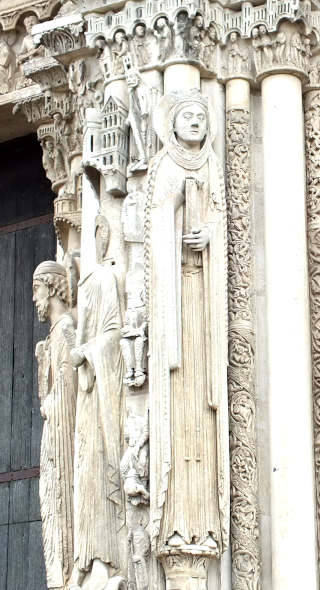
Remarkable medieval sculptures adorning the western facade of Chartres cathedral
Copyright texts and photos © About-France.com
Except photos Maison Picassiette and Maintenon by Patrick
Licenced Creative Commons 2.0
.
Map enhanced from an open-source original by Openstreetmap.org
Key
tourist information for Chartres:
Region: the north of the Centre-Val-de-Loire region.
Nearby cities: Paris, Orleans
Nearest airports: Paris
Population: 38000
Main sites: Notre Dame Cathedral, Picassiette House, Agricultural museum .
Nearby attractions and sites: Maintenon.
Region: the north of the Centre-Val-de-Loire region.
Nearby cities: Paris, Orleans
Nearest airports: Paris
Population: 38000
Main sites: Notre Dame Cathedral, Picassiette House, Agricultural museum .
Nearby attractions and sites: Maintenon.
Access
to Chartres:
Chartres is not a big city. Visitors arriving by car can use the large underground car park located close to the cathedral. For visitors reaching Chartres by train, it is a 750 metre (half mile) walk from the station to the cathedral. To visit old Chartres without having to walk, take the tourist mini train : departure point just in front of the cathedral.
- By train: Chartres is on the Paris - Le-Mans - Brest line (not the high-speed line), and can be reached in just over an hour by direct train from Montparnasse station in Paris. It can also be reached by direct train in an hour and a quarter from Le Mans. Check out train tickets.
- By road: Chartres is on the A11 Paris - le Mans - Nantes motorway an hour west of Paris. It is also on the routes from Calais via Rouen and Orleans to the south and southwest of France.
- By bike: Chartres is on the Véloscénic cycleway from Paris to Mont Saint Michel.
- By air: The nearest airports are Paris Orly and Paris Charles de Gaulle. From there Chartres can be reached by road (85 km from Orly) or by train.
Chartres is not a big city. Visitors arriving by car can use the large underground car park located close to the cathedral. For visitors reaching Chartres by train, it is a 750 metre (half mile) walk from the station to the cathedral. To visit old Chartres without having to walk, take the tourist mini train : departure point just in front of the cathedral.

Remarkable medieval sculptures adorning the western facade of Chartres cathedral
Click here for
low-cost car hire in France
low-cost car hire in France
Copyright texts and photos © About-France.com
Except photos Maison Picassiette and Maintenon by Patrick
Licenced Creative Commons 2.0
.
Map enhanced from an open-source original by Openstreetmap.org
